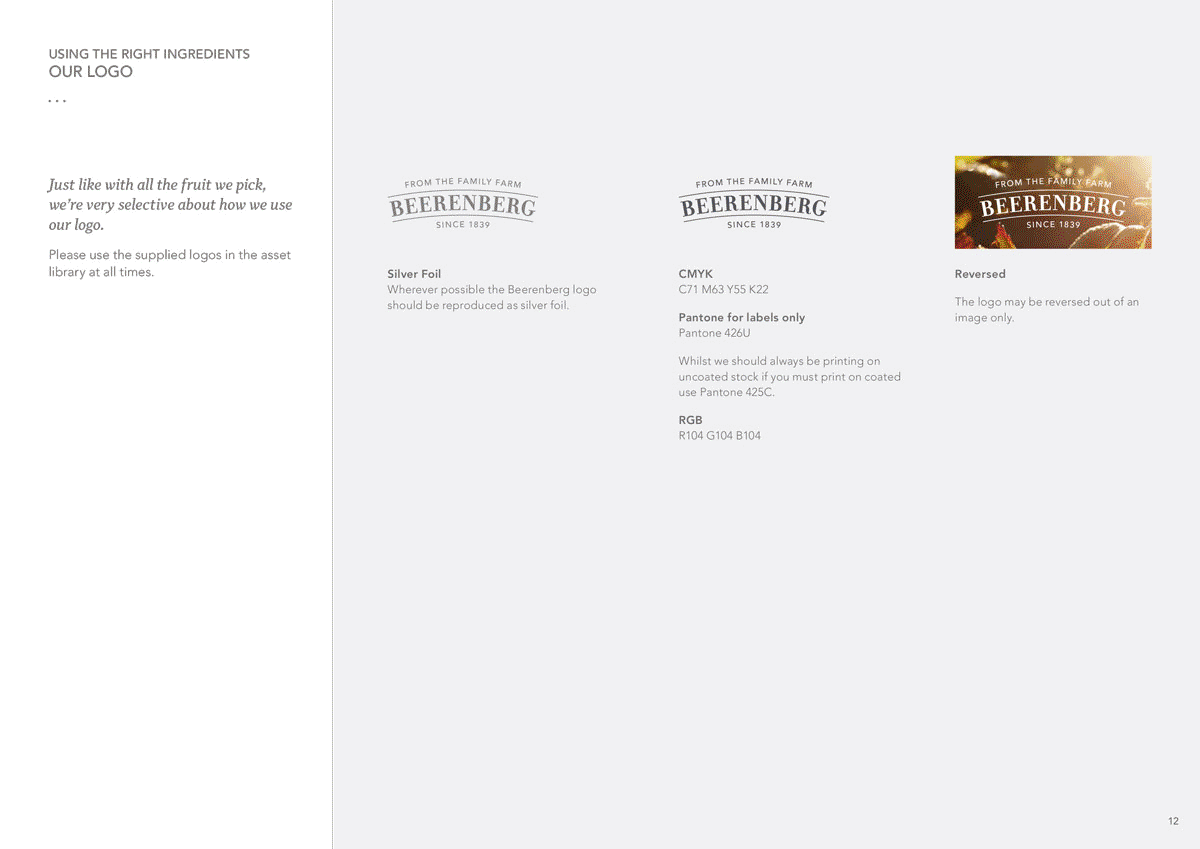From chaos to cohesion: embracing brand guidelines for business growth
We like to call brand guidelines the ‘brand bible’, but another way to think of brand guidelines is as the recipe that tells everyone exactly how to ‘cook’ with your brand.
In this article, we explore why brand guidelines are an integral part of your brand strategy, who should be using them and how, and delve into some brand guidelines examples.
WHAT ARE BRAND GUIDELINES?
Brand guidelines, also known as a brand style guide or a brand book, define your brand’s identity and how it should be presented across different channels, mediums, and touchpoints.
Put simply; strong brand guidelines are a set of rules that outline your visual brand identity, brand voice and key messaging and describe how to use them (and how not to use them!).
WHY ARE BRAND GUIDELINES IMPORTANT?
Brand guidelines are absolutely, 100%, totally, undeniably (okay, we’ll stop now) essential for maintaining brand consistency and integrity.
A consistent brand identity is important for so many reasons and can lead to increased brand recognition, higher profits, more effective brand communication, and higher customer loyalty.
As your business grows and your brand evolves and adapts, brand guidelines also help make sure that all changes align with your core brand identity and brand voice.
Finally, a brand style guide helps make sure that all internal and external stakeholders using your brand are aligned and that no one goes rogue. Imagine if Coca-Cola suddenly changed its shade of red or Nike started using Times New Roman font. Shudder.
WHAT SHOULD BRAND GUIDELINES CONTAIN?

As a minimum, simple brand guidelines should include the following brand elements:
- Logo and logo usage: Specific rules around how and where your company logo should be included, including size restrictions and spacing requirements. Make sure you also include any logo colour variations such as monochrome
- Brand colours: Brand guidelines should include your brand’s primary and secondary colours, complete with colour codes for print and digital
- Typography: Your brand style guide needs to include specific fonts, what context they should be used in (for example title versus paragraph), with their sizes and styles. If you have bespoke fonts, the brand guidelines should include an alternative readily-available font in case your primary fonts are not available
- Imagery and photography: This includes photography style for photoshoots and stock imagery, but also illustration style if this is something that your brand uses
More comprehensive brand guidelines should also include the following:
- Tone of voice: This part outlines your brand’s personality and the kind of language it uses. Why? Because the way your brand speaks is just as important as how it looks. Effective brand guidelines should also include tone of voice details (not sure what your voice and tone is?This article on brand tone of voice will help)
- Animation and video treatments: These are key to your visual identity, and including this information when creating brand guidelines will make sure your motion graphics and video content are cohesive
- Brand strategy and brand story: Hopefully, you’ll have a separate thorough brand strategy document, but you may want to include key elements of your strategy into your brand guidelines – particularly your brand story, purpose, mission, and values
- Key messages: What are the messages about your business that you need to be reinforcing time and time again? Capture these, with variations per audience if needed, so that the substance of what you are communicating is just as consistent as the style
- Marketing materials: Examples of different marketing materials help make the brand guidelines clearer. Add examples for common brand assets such as web pages, flyers, emails, and social media posts
WHO ARE BRAND GUIDELINES FOR?
Clear brand guidelines aren’t just for your internal team but for anyone who interacts with your brand and its assets. This includes:
- In-house marketing teams: Can use the brand guidelines to create consistent campaigns across all channels
- External suppliers: Any external agency or freelancer needs to understand your brand’s look, feel, and voice to produce aligned materials. Your brand guidelines make this easy
- Sales reps and teams: As we know, a cohesive brand identity and brand voice can increase sales. Providing your brand guidelines to your sales reps will help make sure this happens
- Franchises: If you’re running a franchise model, it’s important to make sure that each franchise represents your brand consistently. The answer? Your brand style guide
- HR departments: HR departments need brand guidelines to ensure consistent representation of your company’s values, mission, and visual identity in all internal communications. This will help foster a strong employer brand and enhance employee engagement
HOW DO YOU KNOW IF YOUR BRAND GUIDELINES ARE WORKING?
If your brand guidelines are hitting the mark (and being used effectively), more people will be recognising your brand, and customers will start to feel more emotionally connected and have more trust in your products or services. If they’re not, look out for the following signs:
- Lack of consistent brand representation:Your brand should feel like one big, happy family everywhere it shows up – online, in print, on social media, you name it. If it’s not, then your brand guidelines aren’t being implemented properly
- Lack of team knowledge and confidence: Everyone on your team should know exactly how to present your brand, which means no more head-scratching or wasted time. Speak to your team and see if they feel confident with your brand and how to use it (and also make sure they know why it’s important)
- Confusion and questions: If there is a significant amount of confusion or frequent inquiries about your brand and how to use it, it likely indicates a need for refining the guidelines or providing additional training to your team on their proper usage
WHAT DO YOU DO IF YOUR BRAND GUIDELINES AREN’T WORKING?
If your brand guidelines aren’t working, consider the following:
- Assess if they’re detailed enough: Your brand guidelines should cover all aspects of your brand voice and visuals (check out the list above) – generally they aren’t a one off project but something that will need to be added to by your branding agency over time
- Check their clarity: Your guidelines should be simple and easy to understand. If they’re too complex or vague, they won’t be used correctly
- Make sure they’re being shared with the right people: Anyone interacting with your brand should have access to your brand guidelines – housing them online will mean everyone has access to the most up-to-date version at any time
- Reinforce their importance: It’s so important to make sure everyone understands why your brand guidelines are crucial to the brand’s success
- Provide training or additional resources: This could include setting up easy-to-use branded templates for documents, emails, and social assets or running training sessions
BRAND GUIDELINES EXAMPLES
We’re visual learners over here at Tiny Hunter which is why we want to close up this article on the importance of brand guidelines by giving you some brand guidelines examples. Here are some of our favs.
- Mailchimp: These guidelines clearly show how Mailchimp’s voice, colour palette, and design elements should be used. We also love how they show the process of how the brand was developed and what it means. View the brand guidelines
- TikTok: We love, love, love the interactive nature of this brand book and how it integrates the core brand with practical toolkits. Creating on-brand content couldn’t be easier
So there you have it – a total guide to brand guidelines and why they’re so important. Our main takeaway here is that whether you’re a start-up or an established brand, brand guidelines are not a restriction but a powerful tool that can drive business growth. Create a strong set of guidelines, share them with the right people, and watch your brand succeed.
FAQs ABOUT BRAND GUIDELINES
What are brand guidelines?
Brand guidelines are a set of instructions and standards that define how a brand should be presented visually and verbally, ensuring consistency and coherence across all brand communications.
What are three tips for creating brand guidelines that work?
Clearly define what your brand stands for, keep things consistent across all platforms, and make sure to regularly update and share the guidelines with everyone involved.
Who should create your brand guidelines?
When it comes to creating your brand guidelines, it’s best to involve a diverse group of people, including your marketing teams, brand experts, and key decision-makers.
Are brand guidelines the same as a style guide?
Brand guidelines and style guides are similar but not exactly the same. While a style guide focuses on visual aspects like logos, fonts, and colors, brand guidelines cover a wider range of elements, including your brand’s values, messaging, and overall identity.









